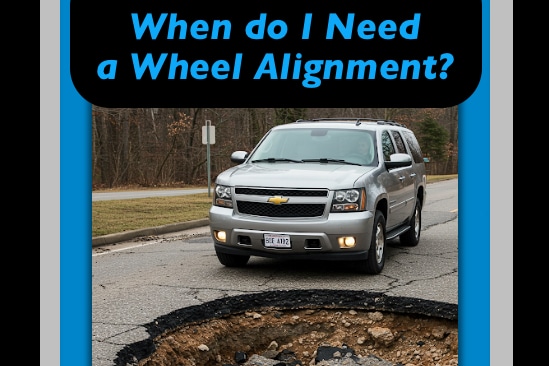
You’re likely aware that when your vehicle wants to veer to the left or right a wheel alignment is probably in order, but there are more symptoms and more complexities to be aware of. Let’s quickly go over indicators of misaligned wheels, what components are connected and therefore at risk (or even possibly contributors), and some tips to keep your car on the straight and narrow longer in the future!
Recognizing the Signs
Before we discuss the "why" let's pinpoint the "when." Here are some of the most common symptoms of a car out of alignment:
- Pulling to one side: Your car drifts to the left or right, even on a flat, straight road. Catching and addressing this sooner than later can save you money on the following…
- Uneven tire wear: One or more tires will show significantly more wear than the others. Depending on the tire’s location and how it’s misaligned the wear pattern can provide a good first indication of the issue.
- Vibrations in the steering wheel: You’ll feel a shaking or vibrating sensation, increasingly at higher speeds. Unsurprisingly, things are getting potentially dangerous at this point.
- Squealing tires: Tires not tracking together can squeal when turning, even at low speeds, meaning you’re essentially shearing the tread from one as it’s pushed at an angle.
If left too long all of these symptoms will eventually lead to a complete part failure, and regardless of the specific part that goes, it will mean a loss of steering.
What Exactly is a Wheel Alignment?
To quickly familiarize yourself with what exactly is getting “aligned”, let’s take an overview of what adjustments are made. Though “wheel” is in the name, the adjustments are actually made through the components connected to said wheel. It varies by vehicle, but tie rods, control arms, and struts are typical points of correction.
If you’ve had your alignment performed at a garage you’ve heard the mechanic use these, or have even seen them on a printout - these are the terms used for wheel angles:
- Camber: The inward or outward tilt of the wheels. If the top of your tire is leaning inward this is “negative camber”, and leaning outward is “positive camber”. Camber is primarily concerned with cornering grip.
- Caster: The angle of the steering pivot from front to back. Consider the fork of a bicycle and how the angle from the top down goes forward - this would be “positive caster”. It aids in straight-line steering stability and returning your steering wheel to the center after a turn.
- Toe: The inward or outward direction of the wheels as seen from above, using your own feet as an example, if your toes are pointed in that’s “positive toe” and pointed out is, of course, “negative toe”. Toe ties in with camber and caster both, as it affects straight line driving as well as proper tracking through corners.
The goal of a proper alignment is to balance handling and stability with tire wear and even energy consumption for overall safety and efficiency. This is a good time to mention that alignment angles vary from vehicle to vehicle, depending on its design and usage. A family sedan, a sports car, and heavy-duty truck, all from the same manufacturer, will likely have different specs. Further, as we’ve hopefully illustrated, the desired goal of these angles probably will not be “0%” as seen from an alignment machine report.
Maintaining Alignment, Tires, and Suspension
As these three are literally connected, the weakening and failure of one will have an adverse effect on the others, so consider this when one calls for attention. Think of basic maintenance as maintaining the entire ecosystem:
- Tires: Regularly checking tire pressure, rotating tires, and ensuring they're properly balanced contribute to even wear and even wear means they aren’t fighting the steering components.
- Suspension: Worn suspension can throw off your alignment, as the energy from bumps and jolts gets passed through the rest of the system. Beyond this, your vehicle can begin to sag as springs lose strength, meaning a change in normal ride height, throwing off the angles in which everything’s designed to perform.
- Regular Inspections: Have your alignment checked periodically. Greensboro has its share of potholes, so even if you haven’t noticed errant steering, getting it checked every year or 12,000 miles can actually save you money and keep your vehicle performing optimally.
- Tire Pressure: This one’s so simple, and thus so easy to overlook, but maintaining the recommended tire pressure saves not only your tires, but added stress on the rest of the system.
- Avoid Potholes: Yes, it’s a no-brainer, and sometimes easier said than done, but dodging potholes, when you safely can, easily extends the life of your steering components.
- Listen to Your Car: Pay attention to any unusual noises or vibrations, and address them promptly. We all probably have a story of a horrible noise that’s mysteriously gone away, but we also know our cars don’t heal from their injuries.
- Routine Maintenance: It’s worth cracking open that user’s manual for more than discovering how to pair your phone to the radio. You might find some important maintenance tips in there of which you weren’t aware.
Investing in regular wheel alignments is an investment in the longevity and safety of your vehicle. We hope we helped shed some light on understanding the symptoms, the process, and the importance of alignment and should you have any further questions we invite you to contact our team today, we’re always happy to help. Stay safe out there, folks!